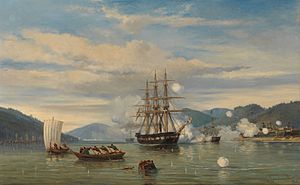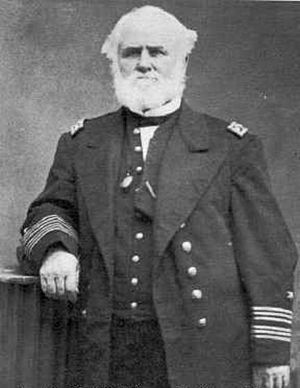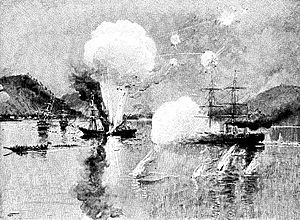Battle of Shimonoseki Straits facts for kids
Quick facts for kids Battle of Shimonoseki Straits |
|||||||
|---|---|---|---|---|---|---|---|
| Part of the First Shimonoseki Campaign | |||||||
 USS Wyoming battling in the Shimonoseki Straits against the Choshu steam warships Daniel Webster, the brig Lanrick, and the steamer Lancefield |
|||||||
|
|||||||
| Belligerents | |||||||
| Commanders and leaders | |||||||
| Strength | |||||||
| 1 screw sloop 198 sailors & marines |
Land: 4 shore batteries Sea: 1 barque 1 brig 1 steamer |
||||||
| Casualties and losses | |||||||
| 1 screw sloop damaged 4 killed 7 wounded |
1 brig sunk 1 steamer sunk 1 barque damaged 40 killed 4 shore batteries damaged |
||||||
The Battle of Shimonoseki Straits (Japanese: 下関海戦, Shimonoseki Kaisen) was a sea battle. It happened on July 16, 1863. The United States Navy warship USS Wyoming fought against the powerful daimyō (a feudal lord) Mōri Takachika. He was the leader of the Chōshū clan in Shimonoseki, Japan.
The USS Wyoming, led by Captain David McDougal, sailed into the strait. It fought alone against the Japanese fleet. This fleet was built in the US but had poorly trained crews. The battle lasted almost two hours before the Wyoming left. McDougal sank two enemy ships and badly damaged another. About 40 Japanese soldiers were killed or hurt. The Wyoming was also damaged. Four of its crew died, and seven were wounded.
This battle was an early part of bigger fights in 1863 and 1864. These were called the Shimonoseki campaign. Several foreign countries worked together in these later battles. This event happened during a difficult time in Japan. From 1854 to 1868, Japan was opening up to European and American powers. This period is known as the Late Tokugawa shogunate.
Why the Battle Happened
In 1863, the Japanese Emperor Kōmei started to take a more active role in ruling. This was unusual for emperors at that time. He was not happy that Japan was opening up to the United States and Europe. So, on March 11 and April 11, 1863, he gave an "Order to expel barbarians". This order meant to kick out all foreigners.
Lord Mōri's Chōshū clan, based in Shimonoseki, followed this order. They decided to remove all foreigners by May 10. Lord Mōri openly went against the Japanese government (the shogunate). He told his forces to fire without warning. They were to shoot at any foreign ships passing through the Shimonoseki Strait. This strait is between Honshu and Kyushu islands.
The Chōshū clan had mostly old cannons that fired round shot. But they also had some modern weapons. These included five 8-inch Dahlgren guns. The United States had given these guns to Japan. They also had three steam warships built in America. These were the barque Daniel Webster (with six guns), the brig Kosei (ten guns, originally Lanrick), and the steamer Koshin (four guns, originally Lancefield).
Attacks on Foreign Ships
The first attack happened on June 25, 1863. An American merchant ship, the Pembroke, was anchored near Shimonoseki Strait. Two European-built warships from the Chōshū clan suddenly fired on it. The crew of one enemy ship yelled, "Revere the Emperor and drive out the barbarians!" The Pembroke managed to escape with only minor damage. No one on board was hurt. Its captain reported the attack to the U.S. Consulate in Yokohama.
The next day, June 26, a French naval ship, the Kienchang, was also anchored. Japanese artillery on the cliffs around Shimonoseki opened fire. The French ship was damaged and one sailor was wounded.
On July 11, the 16-gun Dutch warship HNLMS Medusa sailed into Shimonoseki Strait. Its captain thought Lord Mōri would not fire on his strong ship. Also, the Netherlands and Japan had a long history of good relations. But Mōri still opened fire. He hit the Medusa with over thirty shells. Nine sailors were killed or wounded. The Medusa fired back and sped through the strait. The Dutch Consul General was on board, and the captain wanted to keep him safe.
Soon after, the Japanese warlord had fired on ships from most foreign countries. These countries had consulates (offices for their representatives) in Japan.
The Battle Begins
The American Minister Pruyn approved a quick response to the attack on the Pembroke. So, at 4:45 a.m. on July 14, 1863, Commander McDougal called his crew to action. The Wyoming left 15 minutes later for the strait. After two days, it arrived near Himeshima island on the evening of July 15. It anchored there for the night.
At 5:00 a.m. the next morning, the Wyoming lifted its anchor and headed for the Shimonoseki Strait. At 9:00 a.m., the crew prepared for battle. They loaded their main guns with shells. The warship entered the strait at 10:45 a.m. Soon, three signal guns fired from the land. This warned Lord Mori's batteries and ships that the Wyoming had arrived.
Around 11:15 a.m., the shore batteries fired on the Wyoming. The Wyoming raised its flags and fired back with its 11-inch guns. Captain McDougal ignored the shore batteries for a moment. He ordered the Wyoming to steam toward a bark, a steamer, and a brig. These ships were anchored near Shimonoseki town. Meanwhile, four shore batteries fired at the warship. The Wyoming fired back "as fast as the guns could be brought to bear." Shells from the shore guns flew through the ship's rigging (ropes and masts).
The USS Wyoming then passed between the brig and the bark on one side, and the steamer on the other. They were very close, within pistol shot range. A shot from either the bark or brig hit near the Wyoming's front gun. It killed two men and wounded four. Elsewhere on the ship, a Marine was killed by a piece of shrapnel.
The Wyoming briefly got stuck in uncharted shallow waters. At the same time, the Japanese steamer moved directly toward the Wyoming. It might have been trying to board the American ship. However, the Wyoming managed to get free. It then fired its 11-inch Dahlgren guns at the enemy ship. It hit the steamer's hull and damaged it badly. Two shots exploded its boilers. As the ship began to sink, its crew left the vessel.
The Wyoming then passed the bark and the brig. It fired at them steadily. Some shells went "overs" and landed in the town. Captain McDougal wrote in his report on July 23, "the punishment inflicted... will, I trust, teach him a lesson that will not soon be forgotten."
After being under fire for just over an hour, the Wyoming returned to Yokohama. It had been hit 11 times. Its smokestack and rigging were badly damaged. Its casualties were light: four men killed and seven wounded. One of the wounded later died. The Wyoming was the first foreign warship to attack to support Japan's "opening" to foreign powers. This opening happened after a period called sakoku (closed country).
The two Japanese steamers sunk by the Wyoming were later raised by Chōshū in 1864. They were then used at the harbor of Hagi. This battle did not stop the Chōshū clan. Their shore batteries were still working. They continued to shell foreign ships. Later, foreign powers formed a strong fleet in 1864. They launched the Shimonoseki Campaign, which was successful.
Images for kids








